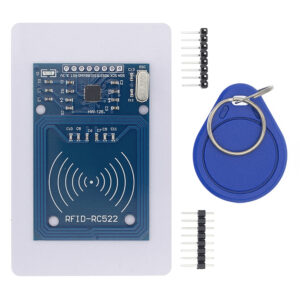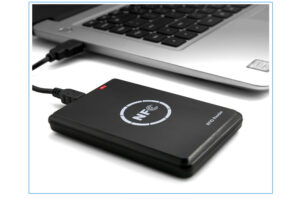RFID Cards/Tags
Thats a topic that causes boredom but some I.T’s may have missed the details, RFID has many applications from security, product marking, a gym membership, to access controls to payment to whatever.
A development rfid module
using the SPI BUS
We got a plethora of technologies that fall in the terms of rfid, a total mess, to many technologies, protocols and confusion
- Low frequency (125khz) card or keychain tag
- High frequency (13.56mhz) card or tag,
- Ultra high frequency (UHF) (960 MHz) Antenna stickers (also known as RFID tags), mostly used in product-inventory management,
- Active RFID – tags (433 MHz, 2.4 GHz, 5.8 GHz) Real-time location tracking, vehicle tracking, asset tracking eg. Apple AirTag
- NFC (13.56 MHz) payments, access control, marketing, ticketing
Passive tags doesn’t have a power-battery them selves, they have an antenna that gives power to their chip from the reader the same way your smartphone can wirelessly charge.
So, now you are able to see the problem, NFC operates at the same frequency as the High frequency tags but the technologies is different some NFC readers will be able to also read the High ones (CUID) if the nfc reader supports ISO 14443, while both NFC, Low and High tags in the eye as key-chain tags or as cards may look identical to you, they are not, even if you see that both are using Mifare technology.
While these identical-looking tags are used all for similar cases, like access control systems. it doesn’t mean they are compatible or the access control system supports all types, in fact, most access control systems will support only one, maybe two if the company is going for compatibility and quality in their products.
Copying them instead of issuing them
That doesn’t apply to product tags and Active ones like Apple’s AirTag as the main need of most of you is to copy your door’s key to have a spare for your apartment, your company or whatever while you don’t have access to the system -device that issues them (eg, alarm, or access control device) or may the Alarm run out of memory slots and you can’t issue more.. whatever is the case for a copy need, would not be about active tags or UHF inventory tags
First you need to identify what the technology is used by the system you want to clone, then you need to buy a tag that supports the exact same tech and frequencies.
Keep in mind some may be easier to copy, eg. in case of NFC you may be able to store the key into your smart phone, in other cases the key may be copied with a cheap copier if it doesn’t use encryption while if it is encrypted you will need to decrypt it in order to copy it.
About encryption algorithms, each tag has a Unique Identification Number that is hard-coded on the chip, that number is used to scramble the information by an algorithm thus only the same tag can be used to de-crypt the information so a copied one that wasn’t copied with decryption in mind won’t match the unique identification number of the old one. Additionally more secure protocols may “Ask” the chip on the tag to do some calculations by sending a challenge to the tag and then read the reply.
You won’t need to do some hacky wacky stuff as there are products designed to decrypt detect and do most of the job automatically.. so you need a copier. there are plenty in the market. some is cheap some expensive.. always read the specs – datasheet to see if the copier is covering your needs and buy the correct keys/cards to play with. You can source rfid copiers on Amazon, AlieXpress and other marketplace/stores by various manufacturers.
NOT RFID tags
What you see on grocery stores – supermakret or whatever stores is probably NOT an rfid tag. but it is using a detection device at the exit of the store that has two huge antennas that you have to pass through. They are using Acousto-magnetic (AM) technology or Radio frequency (RF) systems which is a type of electronic article surveillance (EAS) technology used to prevent retail theft
Radio frequency (RF) systems: These are usually rectangular, while RFID tag antennas and acoustomagnetic are often parallelogram-shaped. But Both technologies have tags with various shapes and sizes available on the market.
Behind the scenes: Unlike RFID, AM technology does not use radio waves. Instead, it uses magnetic fields and acoustics to detect the presence of specially designed tags attached to merchandise.
The radio frequency tag it self is basically a LC resonance circuit, has a metallic antenna and a capacitor. the acousto-magnetic tag if it gets “hit” by the magnetic field it will oscillate at a specific frequency that will produce an acoustic signal the AM tag oscillates at a specific frequency when it is hit by the magnetic field and produces an acoustic signal. While the ones that use radio frequency (RFID, 8.2 MHz) Sensing is achieved by sweeping around the resonant frequency and detecting the dip.
The tags can provide distinct signals and so the system can read different cases of tag passing through. rf tags can be deactivated at the counter by applying a high signal on to them that destroys their capacitor The AM can be deactivated by demagnetizing the strip. and of course they are disposable .(except plastic-cased tags where the staff removes it from the product at the counter)
Thats all folks.






